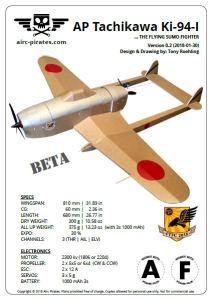AircPirateNinsei
airc-pirates.com
Status: The maiden flight was successfully completed and the BETA-plan is published!

Here is the link to the BETA-plan:

DOWNLOAD FREE BUILD PLAN
Like it flies? See for yourself:
____________________________________________________________________________________________________
Old first post:
Konnichiwa! Here is a Japanese prototype for a heavy fighter you should have seen:
I'm not sure how much wingspan I'm going to build this plane, but there won't be three meters of wingspan, like in this video:
And here's some history:
In the summer of 1942, the Koku Hombu was formulating specifications for a fighter that supported a heavy armament and could operate at high altitude. After settling on thespecifications, the Koku Hombu approachedTachikawa and Nakajima and asked each firm to produce a design to meet these requirements. The specifications for the fighter included a maximum speed of 800km/h (497mph) and arange of 3,OOOkm (1,864 miles). The Koku Hombu knew the demands were high, perhaps even impossible to obtain, and so asked Tachikawa and Nakajima to put forward proposals to meet the demands. But they handicapped Tachikawa by allowing Nakajima to ignore the range requirement. As such, Nakajima could concern themselves with making their design fast without worrying about how far it could operate. Undeterred, Tachikawa's designers set about the task of coming up with a concept that would achieve what the Koku Hombu asked for. What resulted was a departure from the conventional. lt was decided that two Mitsubishi Ha-211 Ru (Ha-43 Ru), 18-cylinder, air-cooled radial engines should be used placed in the fuselage in a push-pull configuration. The key advantage this offered was a reduction in drag over a more conventional, wing mounted engine arrangement. Secondly, the centreline thrust symmetry of the aircraft would be maintained in case of engine failure which, in turn, allowed for nearly no loss of control. Each engine was to drive a fourbladed propeller. A twin-boom arrangement was mated to the low mounted wings. For weapons, a 30mm Ho-155 cannon was fitted into each wing while a (couple of) 37mm Ho-2044 cannons was situated directly below the Ho-155, installed in the tail boom. If required, the Ki-94-1 would be capable of carrying up to 500kg (1,1 021b) of bombs. The Ki-94-1 was to use a pressurised cockpit for the pilot and featured a tricycle landing gear. Once the Ki-94-I was finalised, construction began on a wooden mock-up to be completed in October 1943.
Tachikawa then invited representatives from the Koku Hombu to visit and inspect the Ki-94-I. On inspection and review, Tachikawa was to be disappointed when the design was rejected outright. The Koku Hombu inspectors found the Ki-94-I to be too unorthodox, too complex to build and that Tachikawa's performance estimates were optimistic. Tachikawa, however, did not give up on the Ki-94-1 and reworked the aircraft into a heavy fighter that was designated the Rikugun Kogiken Ki-104. To boost the armament, two 57mm Ho-401 cannons were added. Unfortunately, this design was also rejected. With the rejection of the high altitude fighter and the subsequent heavy fighter revision, Tachikawa finally abandoned the Ki-94-I.

Here is the link to the BETA-plan:

DOWNLOAD FREE BUILD PLAN
Like it flies? See for yourself:
Old first post:
Konnichiwa! Here is a Japanese prototype for a heavy fighter you should have seen:
I'm not sure how much wingspan I'm going to build this plane, but there won't be three meters of wingspan, like in this video:
And here's some history:
In the summer of 1942, the Koku Hombu was formulating specifications for a fighter that supported a heavy armament and could operate at high altitude. After settling on thespecifications, the Koku Hombu approachedTachikawa and Nakajima and asked each firm to produce a design to meet these requirements. The specifications for the fighter included a maximum speed of 800km/h (497mph) and arange of 3,OOOkm (1,864 miles). The Koku Hombu knew the demands were high, perhaps even impossible to obtain, and so asked Tachikawa and Nakajima to put forward proposals to meet the demands. But they handicapped Tachikawa by allowing Nakajima to ignore the range requirement. As such, Nakajima could concern themselves with making their design fast without worrying about how far it could operate. Undeterred, Tachikawa's designers set about the task of coming up with a concept that would achieve what the Koku Hombu asked for. What resulted was a departure from the conventional. lt was decided that two Mitsubishi Ha-211 Ru (Ha-43 Ru), 18-cylinder, air-cooled radial engines should be used placed in the fuselage in a push-pull configuration. The key advantage this offered was a reduction in drag over a more conventional, wing mounted engine arrangement. Secondly, the centreline thrust symmetry of the aircraft would be maintained in case of engine failure which, in turn, allowed for nearly no loss of control. Each engine was to drive a fourbladed propeller. A twin-boom arrangement was mated to the low mounted wings. For weapons, a 30mm Ho-155 cannon was fitted into each wing while a (couple of) 37mm Ho-2044 cannons was situated directly below the Ho-155, installed in the tail boom. If required, the Ki-94-1 would be capable of carrying up to 500kg (1,1 021b) of bombs. The Ki-94-1 was to use a pressurised cockpit for the pilot and featured a tricycle landing gear. Once the Ki-94-I was finalised, construction began on a wooden mock-up to be completed in October 1943.
Tachikawa then invited representatives from the Koku Hombu to visit and inspect the Ki-94-I. On inspection and review, Tachikawa was to be disappointed when the design was rejected outright. The Koku Hombu inspectors found the Ki-94-I to be too unorthodox, too complex to build and that Tachikawa's performance estimates were optimistic. Tachikawa, however, did not give up on the Ki-94-1 and reworked the aircraft into a heavy fighter that was designated the Rikugun Kogiken Ki-104. To boost the armament, two 57mm Ho-401 cannons were added. Unfortunately, this design was also rejected. With the rejection of the high altitude fighter and the subsequent heavy fighter revision, Tachikawa finally abandoned the Ki-94-I.
Last edited:


















